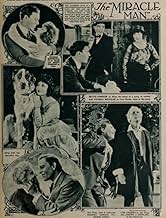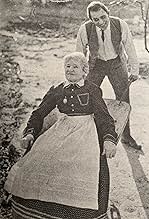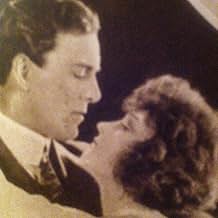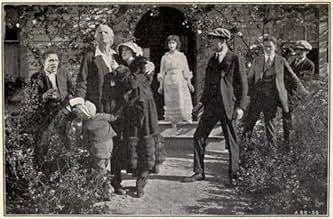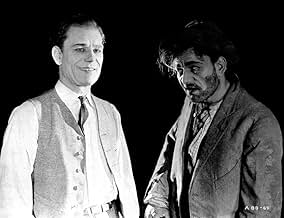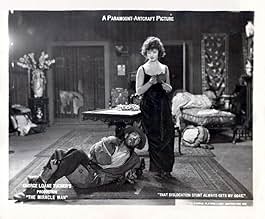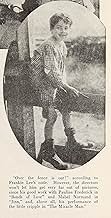Ajouter une intrigue dans votre langueA gang consisting of the Frog, who can dislocate his limbs; the Dope, a drug addict; Rose, who poses as the Dope's brutalized mistress; and Burke, the leader; prey on the sympathies and cont... Tout lireA gang consisting of the Frog, who can dislocate his limbs; the Dope, a drug addict; Rose, who poses as the Dope's brutalized mistress; and Burke, the leader; prey on the sympathies and contributions of Chinatown sightseers, until Tom, reading about a deaf, mute, and nearly-blind... Tout lireA gang consisting of the Frog, who can dislocate his limbs; the Dope, a drug addict; Rose, who poses as the Dope's brutalized mistress; and Burke, the leader; prey on the sympathies and contributions of Chinatown sightseers, until Tom, reading about a deaf, mute, and nearly-blind supposed faith-healer called the Patriarch, living upstate, plans to take greater advanta... Tout lire
- Réalisation
- Scénario
- Casting principal
- Richard King
- (as W. Lawson Butt)
- The Jap
- (as Thomas Kurihara)
- Crippled Boy
- (non crédité)
Avis à la une
"The Miracle Man" is one of the most missed of all "lost" silent films. Presently, only a few minutes of footage is available - and, while several missing films can be enjoyed when ten or so crucial minutes are available, what is left of "The Miracle Man" barely scratches the surface. The film's emotional centerpiece, according to nearly all accounts, is among what we do have. First, a portion introduces cast-members Thomas Meighan, Betty Compson and Lon Chaney. Next, the scene where Mr. Chaney "fakes" his cure is followed by a crippled boy (Frankie Lee) walking, then running toward "Miracle Man" Dowling. Chaney is terrific, especially in a frame witnessing the miracle, but so is the kid...
Contemporary critics were ecstatic about the film, and viewers made it a big box office hit. It advanced the careers of the aforementioned trio of co-stars, who received much praise for their acting. For the year, "Quigley Publications" noted "The Miracle Man" and director George Loane Tucker as the year's best picture and director. It also won a "Photoplay" poll, besting "Broken Blossoms" (1919). However, the latter D.W. Griffith film topped "Miracle Man" in rival "Motion Picture" magazine's contest, with Lillian Gish getting the top acting honor. "The New York Times" placed "Blossoms" at #1 and "Miracle Man" at #2 for 1919. More of "The Miracle Man" would be a welcome sight...
********** The Miracle Man (8/26/19) George Loane Tucker ~ Thomas Meighan, Betty Compson, Lon Chaney, Joseph J. Dowling
Meighan had seen the George M. Cohan play, and was determined to see the film made. Meighan, a personal friend of Cohan's, convinced him to sell the rights to the play for $25,000, a steep price in those days for a story. The film is actually much closer in story to the Frank L. Packard novel than to Cohan's play. Director George Loane Tucker was assigned the project.
In Dec. 23, 1918, Betty Compson received a call after work one day from Tucker. He wanted to talk to her about a new picture he was going to make. After meeting with her, Tucker offered her the role of Rose in The Miracle Man for $125 a week. Not to mention, after Lon Chaney's success in the William S. Hart picture, Riddle Gawne, Tucker had asked him to play in the film The Miracle Man as well. Tucker described to Chaney the various roles in the film, including that of the cripple (The Frog) who played such an important part in the story. Chaney immediately decided that his whole future rested on getting it. Tucker chose Chaney only after interviewing a number of real contortionists who unfortunately couldn't act. He was reportedly "shaken" by Chaney's performance.
The story is certainly fascinating, one that has surely not dated in any way. Four crooks live in New York's Chinatown, working one scheme after another to bilk money from the gullible public. Tom Burke (Meighan) is a slick con man and the leader of the gang. Rose (Compson) is a pretty girl who begs money from sightseers so that she may give up her life of sin. The Dope (J.M. Dumont) is a drug friend who pretends to be Rose's pimp, and The Frog (Chaney) is a contortionist who can bend his limbs into unimaginable twists and turns. One day, Burke discovers a newspaper clipping about an old Patriarch near Boston who has the power to heal. Seeing an opportunity, the four go to the town where they plan to use the Patriarch (Joseph Dowling) to set up a faith-healing sham. Burke senses trouble when his cohorts begin to change under the influence of the healer. The Dope gives up his needle, The Frog reforms and takes the place of the son of a widow who has no one left to care for her, and Rose spends her time mooning over millionaire Richard King (W. Lawson Butt), who has left town. Burke becomes incensed at Rose's interest in the millionaire, but when Richard returns to propose marriage, Rose realizes that it is Burke who she really loves. The Patriarch dies, and Rose and Burke are ready to start a better life together.
The film gave birth to the phrase: "Don't step on it, it may be Lon Chaney!" and brought him to the attention of Hollywood for his outstanding ability to effectively unfurl his "crippled" body in front of the cameras. He not only showed his acting talents but his skills for make-up, which h e learned in his years in vaudeville. Chaney chose paralysis as his character's handicap as it avoided prolonged make-up sessions between the times he had to appear normally for the cameras. The Miracle Man proved a success and Chaney and Tucker became close friends, they planned many projects together (Chaney had even intended to direct one of Tucker's productions) and Tucker's sudden death was an event that greatly upset Chaney.
Unfortunately, this 8-reel silent classic is now nothing more than a forgotten lost film but for a minor portion. Only two fragments of the film remain in existence, one is of the climactic healing scene, which a millionaire brings his crippled boy down to see the Patriarch, all other treatments for the boy having failed. As the crowd gathers, The Frog appears, horribly contorted, and begins to crawl towards the Patriarch, his limbs gradually unbending as he comes closer to the man. The crippled boy, his faith restored at what he believes to be a true miracle, throws down his crutches and begins to walk. It was praised by critics as one of the most powerful scenes yet put on film. Seeing Chaney crawling in twisted pain toward a faith healer called the Patriarch is still as compelling as when Exhibitors Trade Review marveled at this "ghastly deformed mass of flesh faked for the purpose of exciting pity."
Le saviez-vous
- AnecdotesBelieved to be lost, except for one scene included in Paramount's "Movie Milestones" series, as well as a segment in The House That Shadows Built (1931).
- ConnexionsFeatured in The House That Shadows Built (1931)
Meilleurs choix
Détails
- Date de sortie
- Pays d’origine
- Langues
- Aussi connu sous le nom de
- The Miracle Man
- Lieux de tournage
- Société de production
- Voir plus de crédits d'entreprise sur IMDbPro
Box-office
- Budget
- 120 000 $US (estimé)
- Durée
- 1h 20min(80 min)
- Couleur
- Mixage
- Rapport de forme
- 1.33 : 1

